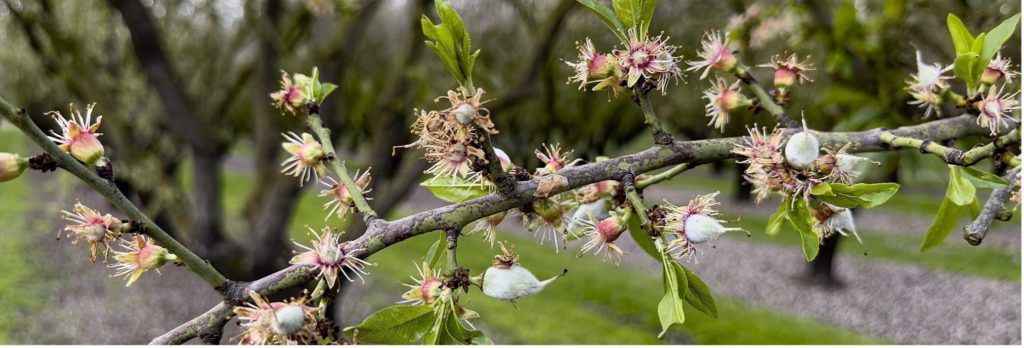

Laura Gerhard
Vice President
OVERVIEW
Shipments for the month of February were 221 million pounds reflecting a 6% decrease from the previous month and a 10% decrease from last year’s record February. Export shipments, which had shown strength over the past four months, eased off a bit at 162 million pounds which is down 14% to last year. Domestic shipments reached 59 million pounds, up 2.3% compared to last year. Despite the monthly fluctuations, total shipments after the first 7 months of the year remain 5.6% ahead of last year’s pace.
SHIPMENTS
India: Shipments to India were 27 million pounds, marking a 21% decrease from last year. Despite softer February shipments, India remains a strong and reliable market for the industry with year-to-date shipments up 18% compared to last season. Buying activity remained relatively muted aside from some business getting done at the MEWA and Gulfood shows. Buyers were mainly on the sidelines awaiting price reaction to the positive bloom news. Activity is expected to pick up in the coming weeks given Diwali needs will need to be largely covered out of the current crop.
China/Hong Kong/Vietnam: Shipments to the region totaled 9.8 million pounds, down 57% to last year, yet year-to-date shipments are now 1% ahead of last season. Buying activity was mostly quiet coming out of Chinese New Year, with mixed reports on consumer demand during the holiday. This has caused many buyers to take a conservative approach to the market. Additionally, local prices are trading at a discount to import prices. Demand is expected to remain quiet for the coming weeks as buyers turn their attention to the Australian crop.
Europe: Shipments to the region remained strong and totaled 61 million pounds, an 11% increase over last year, maintaining the year-to-date shipment pace 8% ahead of last season. Western Europe is now up 11% on the year with strong February shipments to Spain, Germany, Netherlands and Italy. The industry is forecasting good demand going forward given low inventories and buyers purchasing hand-to-mouth.
Middle East: Shipments to the Middle East were 27 million pounds, down 15% to last year. Year-to-date sales are over 3% ahead of last season. The region remains a strong destination for California almonds. The Ramadan holiday started March 10 and will last to April 10. Demand is expected to perform well, supported by favorable consumer disposable income. Performance during Ramadan will be evaluated by the end of March as the holiday enters its final days.
Domestic: February shipments reached 58.8 million pounds, up 2.3% from the prior year, marking the largest February shipment in the last three years and the third-largest in the last decade. Year-to-date shipments have fluctuated compared to last year but ultimately remain flat year-to-date at -0.18%. New domestic sales for the month totaled 62.9 million pounds, bringing commitments to 266 million pounds. Overall domestic commitments remain behind by 19.4% from the prior year but improved from 24.9% in January. The short-term booking strategies for many buyers indicate there is ample volume for new bookings this crop year. It will be important for buyers to consider lead times for new business to ensure there are no gaps in product availability.
COMMITMENTS
Total commitments stand at 631 million pounds, reflecting a 20% decrease compared to last year. This is a 4% improvement versus last month. New Sales for the month reached 215 million pounds, up 13% to last year bringing total new sales after 7 months to match last year’s pace. This coupled with strong shipments are a positive sign for demand given firmer pricing this season. Assuming a 2.45 billion pound crop, shipments and commitments represent 70% of total supply versus 69% last year. The industry is on pace to reach a carryout of nearly 500 million pounds, a level not seen in the past three years. This development is encouraging and is expected to provide some much-needed price stability going forward.
CROP
The almond bloom concluded with mostly positive reports despite occasional rain and strong winds. Overall, bloom conditions were favorable and bee flight hours were sufficient, setting a positive tone for the start of the 2024 crop. The focus is now on post-bloom activities and pest management. The market will continue to monitor crop development through the spring and summer months. While the season is off to a good start, it is still quite early to begin forecasting the potential crop size.
|
Market Perspective Shipments eased a bit in February with some vessel delays hitting in the last half of the month. However, the industry remains on pace to reduce the carryout down to a more manageable 500 million pounds. The bloom took center stage this month, prompting buyers to adopt a conservative approach in response to the positive news. As a result, prices have softened in recent weeks on limited activity. On the other hand, there are positive signals of price support given strong shipments for the year, a smaller crop and dwindling supplies of premium varieties and sizes. As the almond bloom winds down, the industry will closely monitor the crop development with some already starting to predict production. The next major milestone will be in May when the USDA releases its Subjective Estimate. |
To view Blue Diamond’s Market Updates and Bloom Reports Online Click Here
To view the entire detailed Position Report from the Almond Board of California Click Here
